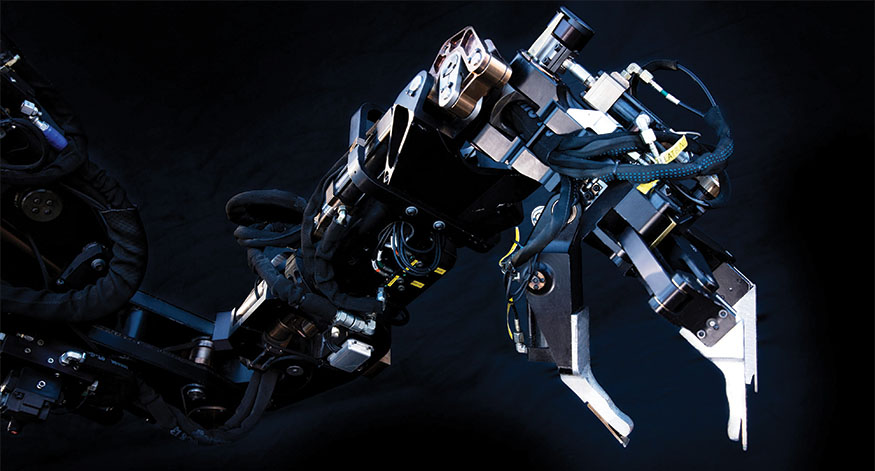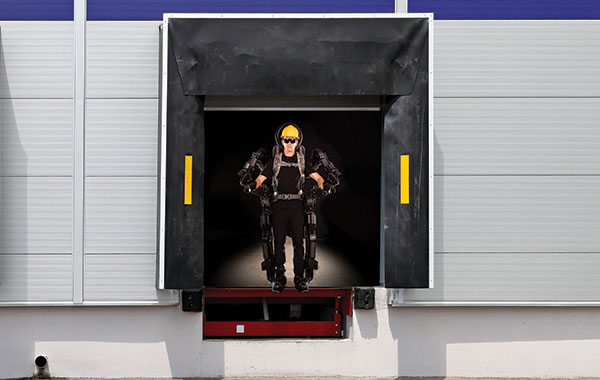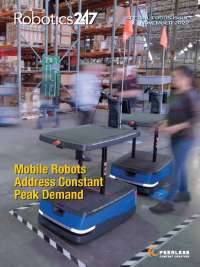To hear John Santagate tell it, in the not-too-distant future we’ll see warehouse dock workers wearing robotic exoskeleton suits and lifting 200-pound boxes in Ironman-esque fashion with no other assistance.
With very little exertion, and without the typical ergonomic problems associated with the continuous lifting and moving of heavy items, these futuristic “exosuits” will help ensure higher safety levels—and a speedier process overall—in an area of the warehouse where hefting heavy loads is the norm.
This is just one example of how the convergence of humans and robots could play out in the warehouse and distribution center (DC) of the future. Made by companies like Sarcos Robotics, which plans to introduce a powered industrial exoskeleton suit in 2019, these advanced products will help reduce the number of workplace injuries and accidents that cost U.S. employers more than $60 billion annually, according to the U.S. Bureau of Labor Statistics (BLS).
According to data from Liberty Mutual Insurance, the 10 leading causes of the most disabling work-related injuries account for $49.9 billion of that total, with the top three causes being overexertion, falls on the same level, and falls to a lower level.
“Companies are looking for ways to keep employees safer, extend their workers’ longevity, and reduce the costs associated with injury risk,” says Santagate, IDC’s service robotics research director. This will also help companies more effectively deal with issues like the rising costs of hiring and training employees, both of which can be lessened when you reduce the frequency of work-related injuries—which, in turn, lead to more days off.
“Right now, exoskeleton suits with payloads of around 200 pounds are coming down the pike,” says Santagate, “which means a human worker will be able to lift 200 pounds in a repetitive fashion as if he or she was lifting a pencil.” And because a person wearing an exosuit can move around faster than, say, a pallet jack or a forklift, the entire process will be sped up.
As he waits for the superhuman exosuits to be ready for prime time, Santagate is anticipating some of the early use cases for them both on the dock and in the warehouse as a whole. “It’ll be far more flexible than a rigid contraption that’s designed to do the same thing,” he says, “and will allow workers to move in a more fluid manner.”
“Lights out” on the dock
As the picture of the fully automated, “lights out” logistics operation continues to come into focus, the dock is increasingly being seen as an area where robotics can play a role in the loading, unloading, staging and situating of freight.
Rather than using the conventional method of loading and unloading, which typically requires a forklift or pallet truck, robots of various shapes and sizes could take the process to new levels of efficiency and productivity by assisting with the strenuous tasks.

When designing its new 24/7 cold warehouse, for example, Preferred Freezer Services (PFS) installed an automatic truck loading and unloading system that includes a chain conveyor system that can handle 50,000-pound loads in minutes. In fact, from parking the truck to driving away, the entire process takes 10 to 15 minutes. The highly-automated system has also helped PFS reduce its logistics costs, preserve the integrity of its cold supply chain, improve loading and unloading efficiency, and directly integrate with an existing warehouse management system (WMS).
Norm Saenz, managing director at supply chain consultancy St. Onge Company, says that the analysts at his firm are seeing a “surprising” number of new, dock-centric robotics developments, including several new prototypes that have surfaced over the last few years. “At first, we saw a few installations here and there,” he says, “but now we’re seeing some definite development taking place, with robots being used to move ‘fluid’ loads or those that include loose cases transported via tractor trailer or container.”
Saenz points to robots that can be telescoped into a trailer to grab a case and then turn and place it on either a pallet or onto a conveyor as one example of how far robotics technology has come over the last few years.
“This technology isn’t widely used yet, but it can unload a trailer instead of a person doing it,” says Saenz, who also sees automated guided vehicles (AGVs) as a good “current” example of robotics on the dock, where they’ll play a more prominent role in the near future.
Companies like Fetch Robotics, for example, make autonomous mobile robots that can handle “pretty good-sized payloads,” according to Santagate, and that help shippers move pallets (i.e., into the warehouse, or cross-dock to another vehicle) once they’re unloaded from the truck itself.
“Shippers can already use AGVs to load and unload full, palletized truckloads or less-than-truckloads at this point,” Saenz adds, “so that’s the real deal.”
Managing complexities, overcoming challenges
The dock presents some interesting complexities that aren’t necessarily present on the warehouse or DC floor, where automation has been around for years and only getting more advanced and prevalent every year.
“The dock is a dynamic place that requires more than just a fulfillment robot that can traverse the DC floor,” Santagate points out. “On the dock, robots have to be able to pick up pallets, cases, or boxes and then put them on some sort of conveyance system that pulls them off the truck. That’s a lot more complex than other use cases.”
For example, the typical warehouse includes multiple bay doors and plays host to myriad different types of trucks and vehicles during the course of a day. Those trucks come in various configurations and sizes, and they carry different goods (also in different sizes and variations). So, unlike the piece-picking robot that can be trained to identify and select among a certain number of SKUs, the robots working the dock must be more dynamic in nature.
“Robotics are often very effective in standardized scenarios,” says Santagate, “and less so in more unpredictable environments. That’s probably why robotics aren’t being used to unload and load trucks as much as they’re currently being used in other areas of the warehouse or DC right now.”
But that doesn’t mean robotics vendors aren’t developing solutions to those complexities, or that shippers aren’t testing them out on their own docks. In fact, Santagate says vendors like Daifuku’s Wynright division, for instance, designs and markets robots that are specifically designed for use on the dock. Its industrial, robotic arm includes a manipulator or “endo factor” that can grab material off a vehicle and place it onto a conveyor system that, in turn, removes the products from that vehicle in a highly automated fashion.
Yaskawa Motoman’s robotic automation solutions are also being used for loading and unloading trucks, Santagate says. Equipped with a robotic arm and gripper—the latter of which can attach to a mobile conveyance system—the machines enter the back of the truck, pick up the packages, and “drive” them over to a conveyance system that then moves the packages into the warehouse.
The early stages of innovation
According to Bob Doyle, vice president of the Robotic Industries Association, robotics in the warehouse and DC is in the “early stages of innovation” when it comes to the loading and unloading of trucks at the dock. “Robots are roaming around the warehouse floor, but those applications aren’t typically utilized for the actual loading and unloading of freight,” he says.
Looking ahead, Doyle expects some of the visionary robotics technology that’s currently under development to play a larger role on the dock, where robots will be able to load and unload boxes. “At this point, I’ve only seen these in demonstrations of the technology, so I don’t know how much they’re actually being used at the dock,” says Doyle, who points to autonomous forklifts as having particularly high potential in the areas of the DC where trucks are loaded and unloaded.
To shippers who want to integrate more robotics into their own dock operations, Doyle says now is the time to keep your eyes open and be ready to test out and implement these technologies as they’re being introduced.
“The timing is right, as these applications are brought from the research stage to startup to actually applying them in real areas,” says Doyle. “It’s an exciting time. And while we’re still in the early stages, there’s more and more opportunity for companies to utilize automation to help improve their operations, productivity and worker safety.”
Santagate is equally as bullish on the blending of robotics, humans, and freight on the warehouse dock, where e-commerce and omni-channel distribution are both pushing the envelope on order velocities and delivery speeds. He’s also realistic about what those robots will and won’t be able to do. Along with the exoskeleton suits, he also envisions a time when robots can either remove full pallets or build out box- and case-loads in an autonomous fashion—but probably not both—at the same dock door.
“Those two robots are going to look pretty different from one another, and they’re going to be configured differently,” says Santagate. “That’s where some of the complexity is coming in on the design side right now. When you’re talking about warehousing, you’re talking about two different types of deliveries at the bay door.”
About the Author
Follow Robotics 24/7 on Linkedin
About the Author
Follow Robotics 24/7 on Linkedin
Article topics
Email Sign Up



















